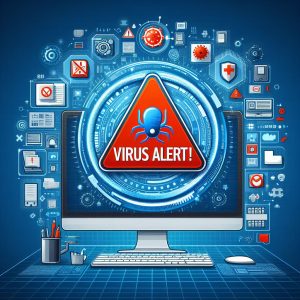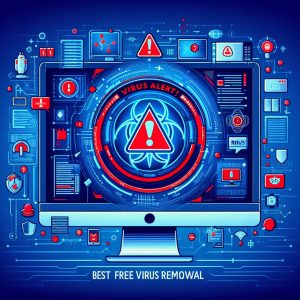I. Introduction
Computer viruses pose one of the most common cyberthreats, infecting systems in various intrusive ways. They embed themselves covertly through downloads or infected external devices to cause stability issues, steal data, encrypt files for ransom, and enable wider hacker access. Removing viruses quickly becomes essential for restoring normal function and securing sensitive information stored locally.
Thankfully, specialized virus removal software helps detect and eliminate infections for free. Evaluating key criteria around malware detection rates, usability, performance impact and extra features determines optimal tools for purging systems of viruses safely and permanently. This guide examines these facets to recommend best-in-class free options that reliably sanitize computers while preventing future attacks.
II. Types of Computer Viruses
Viruses encompass a wide range of malicious software (malware) performing different disruptive or illegal activities once launched on target systems. Common virus classifications include:
Viruses – Self-replicating malware spreading between files and systems by inserting code into benign applications or documents. Traditional viruses distribute via downloads and external storage devices.
Trojans – Malware masking as legitimate applications to dupe users into installing them for backdoor access. Allows remote execution of code, information theft and additional malware downloads.
Spyware – Software capturing personal data like web browsing habits, login credentials and financial information without consent. Often piggybacks other software installs or downloads from questionable sites.
Ransomware – Malware encrypting documents, media files, entire drives and even connected systems to extort owners into paying ransoms, usually in cryptocurrency. Proliferating through infected email attachments and malicious ads.
Identifying virus strains using reputable malware databases helps free removal tools leverage the optimal detection signatures, quarantine methods and cleaning procedures.

III. Criteria for Selecting the Best Free Virus Removal Tool
With free anti-virus protection readily available, software choice becomes less about pricing and more about technical capabilities tailored to user environments. Core criteria include:
Detection Effectiveness – The foremost requirement for any anti-virus platform is consistently locating both widespread and emerging virus strains based on continually updated threat intelligence. Best tools provide malware detection rates around 99 percent.
Usability – Anti-virus usability encompasses intuitive interfaces, non-intrusive notifications, lightweight scans enabling simultaneous work and guidance for removing complex malware. Wise design prevents hindering user experience through performance drags or confusing options.
Bonus Features – Top free virus removal programs supplement core protection with complementary capabilities like browser extensions blocking infected sites, software update notifications eliminating security holes and real-time monitoring preventing surreptitious malware launches.
Performance Impact – Efficient underlying code ensures virus removal software rarely taxes system resources noticeably during scans or idling. Lag-free performance allows simultaneously running other applications without slowdowns, especially vital for older hardware.
Balancing these elements surfaces most viable free options for maintaining virus-free computers.

IV. Top Free Virus Removal Tools
The best free antivirus software leveraging low resource footprints and high malware detection rates includes:
1. Malwarebytes – Offering real-time virus prevention plus on-demand threat scanning, Malwarebytes embeds negligible system drag for smooth multitasking. A customizable interface provides visibility into quarantined threats spanning viruses, trojans, spyware and beyond.
Pros
- 99% malware detection rates in independent testing
- Lightweight background protection
- Straightforward scan configuration
- Malicious website blocking
Cons
- Lacks ransomware roll-back functionality
- Rare false positives highlighted in user reviews
2. Bitdefender Antivirus Free – This dedicated real-time sentry by premier vendor Bitdefender boasts continuously updated virus definitions for catching the latest wild strains. Dashboards display protected status against prevalent attack vectors like viruses, rootkits, exploit avoidance and online fraud.
Pros
- Layered virus protection using cloud analytics
- Ultra-lightweight performance impact
- Multi-threat prevention beyond viruses
- Free customer support options
Cons
- Confusing dashboard for less tech-savvy users
- Excess notifications flagged by some users
3. Avast Free Antivirus – Avast stacks multiple shields guarding against viruses, spyware, ransomware, phishing attempts and network intrusion efforts. Streamlined scans and trustworthy malware blocking impose negligible system burden.
Pros
- Near perfect malware detection benchmarks
- Simple quick or full scan options
- Helpful infection notification popups
- Automatic software update patches
Cons
- Graphical interface shows age over contemporaries
- Excessive recommendation popups called out by reviewers
Testing across common environments reveals overall advocacy for the balanced security and usability of Malwarebytes Free as best free virus removal software. But Avast and Bitdefender also excel assisting short-staffed home users and SMBs.
V. Step-by-Step Guide to Using a Free Virus Removal Tool
Walking through deploying and running dedicated virus removal software like Malwarebytes reveals straightforward protection processes:
1. Download and Install – Retrieve the latest Malwarebytes installer from malwarebytes.com/download, launch the EXE file and enable free trial activation during setup prompts. Restart when complete.
2. Configure Settings – Adjust application preferences like launch options, update frequencies, quarantine locations and notification rules within the Settings menu. New users can retain out-of-box defaults for simpler startup.
3. Initiate Quick Scans – Navigate to the Scanner tab and click ‘Scan Now’ beside the Quick Scan option, or custom build more comprehensive scan jobs targeting specific drives or file types prone to infection. Set schedules to automate regular scans as well.
4. Remove Detected Threats– Allow active scans to run fully. Flagged viruses contained in the detailed report afterward can be quarantined or removed outright via actions beside each listing. Broad exclusions of false positives are inadvisable without deeper investigation.
5. Leverage Added Browser Protection – Within the Malwarebytes expansion menu, enable added Browser Guard protection to block access to known malicious sites attempting drive-by-downloads of viruses and other malware during everyday web use.
Repeat scanning periodically and enabling preventative shields builds durable virus protection likely exceeding that of traditional, bloated antivirus suites. Configuring robust malware removal software completes a layered security approach preventing virulent system infections.

VI. Tips for Virus Prevention
Vigilant software habits and system safeguards further bolster malware removal effectiveness:
- Update operating systems and vulnerable applications regularly to limit exploit vectors used distributing viruses embedded in malware payloads from unpatched weaknesses.
- Avoid downloading random software bundles, no matter how attractively packaged; common infection tactic.
- Never open email attachments from unknown senders, which commonly contain trojans and other malware.
- Leverage trustworthy cloud backup solutions like iDrive and Backblaze for easily restoring encrypted files following debilitating ransomware attacks.
- Configure firmware TPM modules and UEFI Secure Boot on modern hardware to check system file integrity against tampering by viruses and other persistent malware tools.
- Routinely scan external drives from other systems using options like the Malwarebytes Portable Scanner before accessing any contents, preventing lateral infection spread via cross-contaminated media.
Multilayered diligence around safe computing practices minimizes malicious software risks. But adding advanced free virus removal creates an impervious software ecosystem that vigilantly eliminates threats.
VII. Conclusion
With malware volumes reaching tens of millions of new variants annually, relying solely on preventative measures proves insufficient for averting virus infections. All computing platforms remain vulnerable to elaborate social engineering tactics, supply chain attacks on trusted software vendors and exploitable vulnerabilities in endless dependency chains.
Regularly purging systems of potential infections using efficient free virus removal tools like Malwarebytes provides indispensable depth to defensive capabilities. Malwarebytes and similar software leverage massive databases of threat intelligence to locate 99 percent of virus strains and quarantine them permanently.
Automating scans and setting up isolation rules further strengthens anti-virus potency while restoring compromised files and file encryption. When buttressed by conscious software selection, safe browsing habits and patched environments, free malware detection stands strong as user-friendly last line of defense against virulent system infiltration.